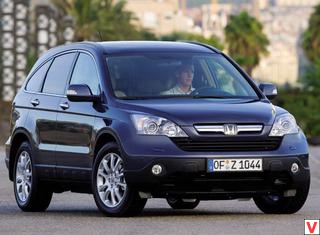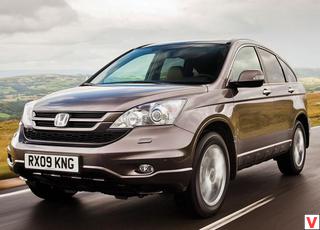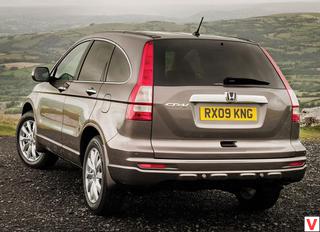Honda cr-v
CR-V debuted in 1995.
2018 Honda CR-V - Review and Road Test

The 2002 model looks much larger than its predecessor, and according to Honda experts, the car has become more comfortable and functional. The total volume of the cabin grew by 8%. Due to the skillful layout of components and parts, the HondaCR-V has the largest cabin in its class - 527 liters.
In the interior there are notes of a sporty, urban spirit. The flat, level floor and the considerable distance between the front seats allow passengers to move freely back and forth through the cabin. The new position of the handbrake lever on the center console has made these movements even easier.
The seats in the CR-V are wide and comfortable. The driver's seat is adjustable in height within 25 mm and moves back and forth a distance of 240 mm. The rear seat, divided in the 40:60 ratio, not only can be moved back and forth, but also rejected its back at an angle of 45 °. If you fold back the backs of the front seats, you get a spacious space for rest. If necessary, the backs of the rear seats can be folded to transport long items. If you flip the rear seats to a vertical position, the trunk volume will increase to 925 liters, which allows you to carry two 26-inch mountain bikes without removing the front wheels. Low loading height facilitates the placement of luggage, and the special design of the suspension and the fuel tank filling the maximum of the available space made of special plastic made it possible to make the boot floor flat and very wide.
As a result, the significantly increased rigidity of the body and the use of new sound-absorbing materials in the passenger compartment, even at high speeds, is very quiet.
In the car a lot of different shelves and pockets for storing small items. There are more than a dozen of them in the door trim, under the seats, on the front panel, near the glove box and even in the tailgate. In total, there are more than 21 "cache".
Built on a new platform, the car is suitable for a large family and behaves well on slippery roads due to the complex all-wheel drive transmission REAL TIME 4WD. If necessary, it independently adjusts the supply of "Newton meters" to the wheels of the front or rear axle. The new model has a compact, technically efficient MacPherson strut on the front wheels and a double independent suspension with a jet lever on the rear wheels. As a result, it was possible to achieve a comfortable ride, no different from a car, stability and ease of operation, as well as excellent behavior on rough terrain. But as a front-CR-V is not intended for the assault of this off-road.

CR-V2002 got a new engine. Rather, in itself it is not new, but taken from the Acura RSX, but the unit has been thoroughly reconfigured and equipped with the i-VTEC system, which changes the phases of the valves. Engine tuning is made with an emphasis on getting maximum thrust. Its capacity is small - 160 l. with., the volume of 2.4 liters, but the schedule of maximum torque practically does not change over a wide rpm range (from 2000 to almost maximum). This engine differs from its two-liter predecessor in high power and high-torque performance. Its high flexibility at low and medium speeds helps to navigate on bad roads, and good elasticity - to maintain high speed on the highway.
Honda does not offer an alternative to this engine.
CR-V is offered either with an improved 5-speed manual or 4-speed automatic transmission with Grade Logic control system. Manual transmission is extremely easy to change gears. Due to the change in gear ratios of the first and reverse gears, the acceleration dynamics of the CR-V with low speeds and when starting from a standstill was improved.
A four-speed automatic transmission with Grade Logic Control System can determine the actual driving situation by making a large number of measurements. Further, based on a number of switching schemes, it selects the appropriate switching points to ensure smooth running. In addition to the three-channel ABS system with four sensors, the CR-V is equipped with an electronic brake force distribution (EBD) system. The EBD system can measure small discrepancies in front and rear wheel speeds to provide the optimum braking effort to the rear wheels through the ABS valves, no matter how heavy the car is and taking into account the change in weight during braking. This allows you to maximize the potential of the rear wheels, as well as reduce the risk of premature locking of the rear brakes when braking at high speed and ensure a clear feel of the brake pedal.
Ahead, the CR-V is equipped with powerful ventilated disc brakes with a diameter of 282 mm, and behind them - solid discs with a diameter of 282 mm. A small drum in the center of the disc works as a handbrake. As standard equipment, all modifications of the CR-V are fitted with front and side airbags for the driver and front passenger, seat belts with two-stage tensioners in the front seats and three-point seat belts in the rear seats, as well as the Isofix child seat anchorage system.

There are two options for the CR-V "Performa" and "Fullmark". The latter is the most fully equipped and decorated car. In addition to the many options, it has such exterior elements as body-colored side mirrors and moldings, chrome grille, cast wheels and a spare tire hidden under the plastic casing. The standard version of the “Regulator” suggests a more modest level of equipment. In this configuration, the CR-V is far from lyric: plastic bumpers and body parts, stamped wheels. This list of standard options “Regforma” is more than convincing - here you can find an air conditioner equipped with a filter, an audio system with a CD player, and much more.
The CR-V car according to test results EuroNCAP is recognized as one of the safest cars in its class. He received 4 stars in passive safety tests and three stars in pedestrian safety tests.
In 2004, at the Paris Motor Show, Honda introduced the diesel version of the CR-V. Since October, sales of this car, equipped with a 2-liter engine and i-VTEC system, began.
The official premiere of the third generation of the CR-V model took place in September 2006 at the Paris Motor Show, and went on sale in early 2007. The purpose of the novelty is to win the sympathy of a larger number of buyers and make a worthy competition to the leaders of this market segment.
Dynamic design, new engine, significantly improved all-wheel drive transmission - this is not a complete list of changes in the Honda CR-V.
Contrary to general trends, when most next-generation cars are noticeably larger than their predecessors, the new CR-V is leaner than the outgoing model. Decreased length, height and base. The only increase is in the width and, accordingly, the track of the front and rear wheels. Thus, the nature of the crossover has changed dramatically. The new CR-V is aimed at an active driver who prefers a car with perfected driving habits.

The appearance of new items is quite controversial. The exterior has changed significantly, the lines of the body and the silhouette of the car have become even smoother and more rounded. Unrecognizable changed front of "SUV". The huge front bumper, slightly climbing on the headlights with plastic protection from below, looks original. Instead of one grille, two are represented at once. One in the same place where it was before, only greatly reduced in size, and the second - between the bumper and the hood. According to the fashion of recent years, the turn signals "moved" to the body side mirrors. A smoother roofline is complemented by a converging line of side windows in the trunk area. By the way, the spare tire has disappeared forever from the back door, having added to the car, together with the lanterns stretched out in the rear racks, a bit of sportiness and grace. In general, the look of the new CR-Vstal is much more cheerful and fun.
The interior is of a high standard. Its modernization was a point. According to the manufacturer, the seats are wider and more comfortable. The interior of the novelty will please not only more expensive and high-quality finishing materials, but also a more convenient location of instruments and controls on a less convex dashboard. The picture is completed by a sporty three-spoke multifunction steering wheel and an abundance of polished aluminum inserts in the cabin, making the interior more stylish and a bit racing. In short, the salon began to look more solid and stylish.
The new CR-V offers an abundance of various drawers, shelves, cupholders, boxes and wide possibilities of transformation. For example, each part of the rear seats divided in the ratio of 40:60 can be moved back and forth by 15 cm. And the back of the sofa is divided in the ratio of 40:20:40. There are as many as five Isofix mounts in the backseat. They allow you to install either two child seats at the edges, or one in the center. If parents are traveling in front, then a small panoramic mirror located on the lid of the ceiling eyepiece will help them to watch the little passengers.
The trunk was smaller (1.72 m³ against 2.03 m³ in the previous generation). Now, to get into it, it is necessary to lift the door up, and not open sideways, as before. The cargo compartment itself can be split in two by a horizontal shelf. It is quite strong and tough, so you get two separate trunks, which is convenient, for example, when transporting sports equipment and products at the same time. And if necessary, this shelf is removed in a few seconds.

There are no cardinal innovations in the engine lineup for the third generation. Will have to choose from friends in the previous model of engines. True, they have undergone significant modernization. The top-end unit was a four-cylinder engine of 2.4 liters, whose power increased by 10 hp. and now is 166 hp It also offers a 2-liter gasoline engine designed based on the well-proven Honda Civic engine (1.8 liters SOHC i-VTEC). Its maximum power is 150 hp. (111 kW) at 6,200 rpm, while the maximum torque is 19.3 kg / m (190 N / m). Working in tandem with a 6-speed manual transmission, this engine is able to show good results in efficiency and speed. So, up to 100 km / hHondaCR-Vs with a new two-liter engine accelerates in 10.2 seconds. In case the engine is aggregated by a 5-speed automatic transmission, the acceleration time to a hundred increases to 12.2 seconds.
Present in the range of engines and a 2.2 liter diesel engine i-CTDi, 140 hp (104 kW).
The design of the suspension is exactly the same as on the previous model. McPherson remained in the front, behind - "multilink". But the designers have seriously worked on its settings. Changed the angles of the wheels, springs and silent blocks.
The car can be equipped with a fully automatic all-wheel drive system. The all-wheel drive transmission of the new CR-V was seriously upgraded.
2018 Honda CR-V | India First Drive Review | Autocar India
The new Honda CR-V is equipped with the latest automotive safety technology solutions. The Adaptive Cruise Control System (Adaptive Cruise Control) allows you to automatically maintain a specified distance between the CR-V and the car in front. And the system Collision Mitigation Braking System (automatic control of the brakes) allows you to warn the driver when there is an immediate danger of a collision, and also include brakes if the driver did not follow the reaction and the road crash situation has worsened.

Advanced TSA (Trailer Stability Assist) stabilization system, designed for driving with a trailer. When he loses stability, the car, as a rule, starts to wind along the road. In this case, the TSA brakes the wheels "diagonally" (front left - rear right or front right - rear left), in anti-phase oscillations, while reducing the speed of the machine by reducing the fuel supply to the engine.
In 2010, the model has undergone a slight modernization. Externally, the CR-V has changed little: an updated grille, a different design of the bumpers and the design of the front light units has become more "predatory." The length of the updated CR-V - 4574 mm, width - 1820, height - 1675; wheelbase - 2620 mm, track - 1565/1565. In a word, it still looks solid and attractive. Also updated the design of wheels and interior.
Interior design has become more modern and ergonomic. Improved noise insulation, reducing the noise level in the cabin by 5 dB. The driver's seat HondaCR-V2010 was created with great care. Comfortable sitting with well-developed lateral support, bright, easy to read devices, controls located under the arms. The front seats move not only longitudinally, but also in height. Plus, the adjustment of the "steering wheel" on the angle of inclination and departure.
The wide range of changes in the HondaCR-V2010's interior includes: modification of radio functionality, changing the structure of the fabric for the seats, updated the design of the door handles and the gear shift lever. Also received a new design dashboard and steering wheel. The AM / FM / CD sound system, installed on the Honda CR-V, has become available in gray and black colors with blue backlighting. To access music files, the CR-VEX-L has an Audio USB Interface. The background color of the Multi-Information Display (MID) is blue (previously black). This color is perfectly combined with the color of the backlight of the sound system. In addition to the functionality of a digital display (MID), which includes an odometer, an on-board computer and other indicators necessary for using the vehicle, the HondaCR-VEX and EX-L (models not equipped with a navigation system) have an integrated compass. On models equipped with a navigation system, recently added functionality in the form of Bluetooth HandsFreeLink. Bluetooth HandsFreeLink is associated with a multi-information display, i.e. the display shows Bluetooth capabilities and actions.
Special attention deserves a roomy trunk. The huge space is replete with hooks and fixtures, thanks to which you can easily fix any cargo. And if you fold the rear seats, the trunk volume increases to 950 liters.

And modern safety technology - "active" and "passive." Standard safety equipment includes: Advanced Compatibility Engineering (ACE) bodywork; Vehicle Stability Assist (VSA) - the system of stabilization of the automobile course; The front end of the body is designed for pedestrian safety design. The additional safety standard includes: side-impact airbags with a rollover sensor; active front head restraints; anti-lock braking system (ABS) with Electronic Brake Distribution (EBD), auxiliary brake, EBD - electronic brake distribution system; front airbags with Occupant Position Detection System (OPDS); Tire Pressure Monitoring System (TPMS), TPMS is a tire pressure monitoring system.
HondaCR-V2010 is equipped with two aluminum engines of the newest generation of the i-VTEC family. Two-liter 16-klapnik R20A3 150 hp accelerates the car to 100 km / h in just 10.3 seconds. However, it is extremely economical - fuel consumption is only 8.2 liters per 100 km. The 2.4-liter engine capacity of 166 hp accelerates the car to 100 km / h in 10 seconds. It is also economical, fuel consumption slightly exceeds the two-liter engine - 9.5 liters per 100 km. HondaCR-V is equipped with two types of transmission: 6-speed manual or 5-speed automatic with Grade Logic system, which ensures smooth and timely gear shifting.
On the North American market, the CR-VID with a 2.35-liter "four" K24Z6: maximum power - 182 hp at 6800 rpm, the highest torque is 218 Nm. By the way, in North America, the car is offered exclusively with automatic transmission. For Europe, a 2.2-liter i-DTEC turbodiesel is also provided: it is tuned to 150 hp. at 4 thousand revolutions, the greatest torque - all 350 Nm.

Low fuel consumption, unusual for most SUVs, is largely achieved through the intelligent all-wheel drive Real Time 4WD system. Under normal conditions, the car works as a front-wheel drive, but in those moments when the front wheels begin to slip, the rear wheels are automatically activated, increasing traction. Although the CR-V is also available in front-wheel drive (Japan, North America).
McPherson front suspension, double wishbones at the rear. Coil springs, transverse stabilizers. In the basic versions, the model is equipped with tires of size 225/65 R17, while in versions the 225/60 R tires on 18-inch light-alloy wheels rely more expensively. Ground clearance - 18.5 cm. Brake discs with a diameter of 293 mm at the front (ventilated) and 302 mm at the rear.
The debut of the fourth generation Honda CR-V was held in March 2012 at the Geneva Motor Show. The Japanese and North American versions of the car appeared at all in November 2011.
The Honda CR-V 2012 model year crossover continues to develop the model, about 65% of the components and parts were updated. This generation has changed slightly in size. In particular, the ground clearance was reduced by 20 mm, and the total length of the body was reduced by 5 mm (to 4529), height - by 30 mm (to 1654). But the width and wheelbase has not changed - the same 1820 and 2620 mm, respectively. However, as the size of the front and rear track, which does not exceed the previous 1570 and 1585 mm. Ground clearance has decreased from 185 to 165 mm.

The luggage compartment volume increased from 556–1530 liters to 589–1669 liters, and the boot floor became lower by 30 mm. The folding mechanism of the second-row seats consists of two levers (one for each part of the sofa, the proportions are 60 by 40), the cushion leans to the front seats, and the back of the back gently lays down on the floor. The result is a flat platform. Loading height of the trunk decreased by 25 mm. In expensive versions, the tailgate is equipped with an electric drive that does not close if there is an obstacle in the door’s path.
The design of the car has changed dramatically. The "bulldog grin" of the radiator grille is gone - its place was taken by the radiator grille, flowing to the headlights. Looks original. Bumpers have decreased - on both sides, all the lighting has been done differently. Rear lights, for example, now go to the sidewalls. Seriously redone the entire rear of the car and, above all, the windows behind the rear doors. They now have a less elaborate shape and the car has not only acquired a large glass area, but also looks longer than it actually is. Altered doors, doorways and sills.

Inside the Honda CR-V has changed no less radically than the outside. The new dashboard received a huge speedometer with a screen on-board computer inside the dial. The rest of the instruments, including the tachometer, are located on its sides. Automatic lever on the usual place - made in the salon "beard". Under the windshield - a standard five-inch screen, on the panel - an optional, i-MID information system, which displays a map navigator or image from the rear view camera. It is noteworthy that for the American market i-MID is standard equipment.
No problems with ergonomics: all screens are clearly visible to the driver, the contrast dashboard is readable in any weather and any time of day, and the landing has become more comfortable due to the increased seat adjustment ranges in height and steering column in all directions (50 mm and 10 mm, respectively) .
About the technical details. For the Russian version of the CR-V is available 2-liter power unit with a capacity of 150 "horses." The torque indicator of this engine is 190 Nm. It works with a choice of either a 6-speed manual type box, or a 5-speed automatic, with a torque converter and electronic control. On machines of European specification, the unit complies with Euro-5 standards and develops 155 hp. and 192 N • m, while consuming less fuel.
The ECON button activates the economical mode of operation of the power unit and air conditioner. Under the large green button are the control buttons for other equipment: headlight washers, parking sensors, a descent system, a stabilization system (partially deactivated), an electric tailgate and a CMBS collision avoidance system.
Engineers revised the deformation zones of the body, increased bending stiffness by 7% and torsional stiffness by 9%. Curb weight increased. So, cars with a two-liter gasoline engine and "mechanics" weigh 1517 kg instead of the previous 1498, and with the "automatic" - 1542 kg against 1533.